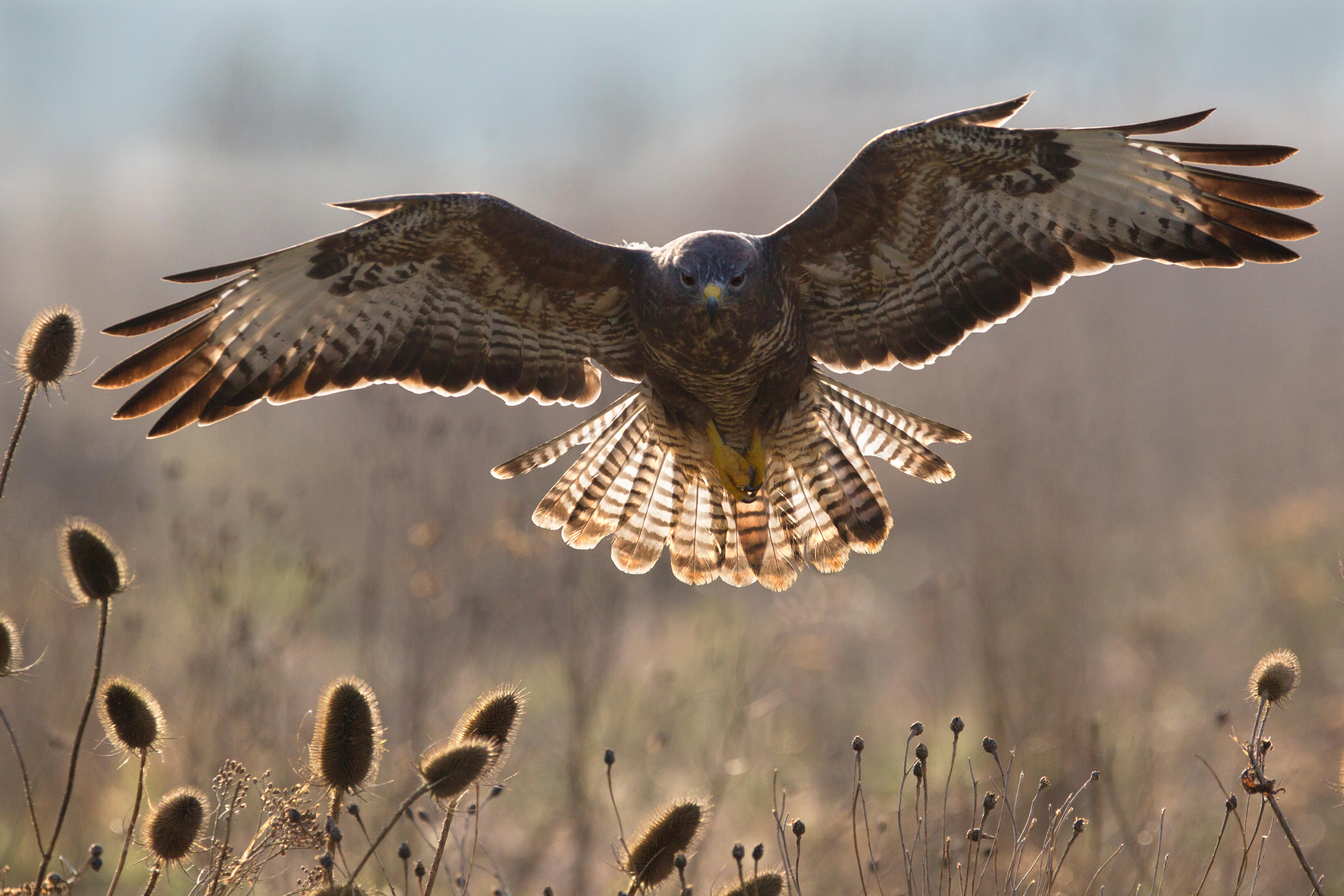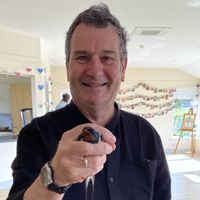How the acrobatic buzzard survived persecution to become one of Britain's best avian hunters
It may appear lethargic, but no one could argue with the hunting prowess of the common buzzard when it transforms into a surging missile intent on an unsuspecting victim.


Of all our raptors, common buzzards (Buteo buteo) are the most likely to provide us with the twin pleasures of sight and sound. In those peerless blue skies on sunny afternoons in late March, buzzards are invariably on the wing performing near-effortless spirals as they fire down salvoes of the softest, rising cat-like call. Mewing buzzards in display are one of the most affecting indicators of the British spring and now part of its very essence.
There are at least 64,000 pairs spread more evenly through these islands than any other raptor, but this wasn’t always the case. In the early 20th century, persecution had driven them to the western fringes and, even as late as the 1970s, the species was almost trapped to the west of a line between Southampton and Liverpool. Their strongholds were in the West Country, Wales and also in the Highlands of Scotland.
At that time, the bird was almost unknown in eastern England. This all changed at the end of the 20th century, when they started to expand in range and number and I well recall my first ever buzzard in Norfolk — it was 1994 and, within only eight years, I saw my first breeding birds. Today, in some wooded parts of East Anglia, it isn’t uncommon to find a dozen circling in unison. They particularly favour woodland or plantation forests of all kinds, but they have spread into arable farmland and even the rather treeless sheep country of northern England.
One secret to success is the bird’s flexibility in matters of prey and one of the most common sightings many of us have of it involves a rather comical scene. A rotund brown creature, with an almost chicken-like waddling gait, will be loping across some short-cropped field right at the roadside. Slowly, it dawns on you: it is a buzzard pulling up earthworms, which are a dietary mainstay in lean times.
That modest fare is in keeping with historical opinions of the buzzard and a rather lowly estimate of its hunting ethics. One 19th-century ornithologist suggested that it was a ‘dull, stupid, heavy… lazy, sleepy and cowardly fellow, who dozes away half his time on some old rotten stump’. Had this critic bothered to watch a little longer, he might have seen something more impressive: when a buzzard suddenly transforms from quiet sentinel to surging missile intent on some unsuspecting victim.
In Britain, it is often rabbits that are caught in this way. They are a key element in the diet and the raptor was badly affected by the myxomatosis outbreaks of the 1950s. Studies in mainland Europe suggest that small mammals may also be a major dietary component, but buzzards are able to take birds as large as grouse, pheasants, crows, jays, rooks and wood pigeons.
One memorable encounter I recall involved a mother and her full-grown young. They were circling over a steep, gorse-covered slope in the Peak District, which was densely riddled with the burrows of a large rabbit colony. Following their parents’ lead, the young birds tested their mettle, hurtling at speed, almost brushing the ground as they careered after scampering bunnies in playful sorties. It may have been hunting school for the youngsters, but it was risky stuff swooping through the armoury of gorse spikes. There was nothing ‘lazy’ or ‘cowardly’ on show here.
Exquisite houses, the beauty of Nature, and how to get the most from your life, straight to your inbox.
One of the more recent shifts in our experience is the way we have to look carefully at large birds of prey to confirm their identity. In many parts today, any raptor could be one of three or four species. Buzzards are the most abundant, but they are not always easy to separate and show an astonishing plumage variation, from almost completely fulvous-white birds right through to solidly black individuals.
The real giveaway is when a buzzard takes flight. There is invariably a silvery crescent through the middle of the underwing that flashes as the bird banks. Then, it planes away and you get the full breadth of the rounded span, together with a broad, rounded tail. Without a flap, it twists and rises until barely visible high in the ether. Finally comes the telltale moment: those inflected pieeeuu pieeeuu notes that lend a sense of wildness to every British scene.
Mark Cocker is a naturalist and multi-award-winning author of creative non-fiction. His latest book, ‘One Midsummer’s Day: Swifts and the Story of Life on Earth’, is out in paperback (Vintage, £10.99)
Mark Cocker is a naturalist and multi-award-winning author of creative non-fiction. His last book, ‘One Midsummer’s Day: Swifts and the Story of Life on Earth’, is out in paperback. A new book entitled 'The Nature of Seeing' will be published next year by Jonathan Cape.
-
 Is this the end of the Forever Home?
Is this the end of the Forever Home?The classic dream of finding a family house in which you can settle down, raise a family and grow old has never been harder to obtain. So has the concept of the 'Forever Home' had its day? Annabel Dixon reports.
-
 HO HO House of Commons: If I had to buy all of my Christmas presents from Parliament this is what I’d get and for who
HO HO House of Commons: If I had to buy all of my Christmas presents from Parliament this is what I’d get and for whoThe House of Common’s gift shop has got everything from a plushie of Attlee, the Speaker’s miserable looking cat, to a rubber duck that pays tribute to the mighty work of the Suffragettes.
-
 'It is hard to beat the excitement of watching a peregrine you have trained stoop from 1,000ft, going more than 100mph' — the complicated world of falconry
'It is hard to beat the excitement of watching a peregrine you have trained stoop from 1,000ft, going more than 100mph' — the complicated world of falconryA combination of spellbinding sport and profound empathetic connection, falconry–a partnership in which the bird maintains the upper hand–offers a window into ‘the deeper magic’.
-
 What is everyone talking about this week: More than half the country owns a pet and nearly half our marriages end in divorce — no wonder pet-nups are on the rise
What is everyone talking about this week: More than half the country owns a pet and nearly half our marriages end in divorce — no wonder pet-nups are on the risePet-nups, a formal agreement between couples over what should happen to their pets in the event of a split, are on the rise.
-
 Haute dogs: How fashion’s finest would dress 11 dogs and one very spoilt cat if only they had the chance
Haute dogs: How fashion’s finest would dress 11 dogs and one very spoilt cat if only they had the chanceWe’ve matched some much-loved breeds to the designers that share their history, temperament and vibe — because why not. Illustrations by Tug Rice.
-
 Baby, it’s cold outside (even if you have a natural fur coat): How our animals brave the winter chill
Baby, it’s cold outside (even if you have a natural fur coat): How our animals brave the winter chillWhen the temperature drops, how do Britain’s birds, beasts and plants keep the cold at bay? John Lewis-Stempel reveals Nature’s own thermals.
-
 Yorkshire’s bravest and most charming gentleman — the Airedale terrier
Yorkshire’s bravest and most charming gentleman — the Airedale terrierBred on Yorkshire’s riverbanks to face otters, snakes and even enemy fire, the Airedale has gone from the trenches of war to the hearts and homes of presidents and movie stars.
-
 Dangerous beasts (and where to find them): Britain's animals that are best left alone
Dangerous beasts (and where to find them): Britain's animals that are best left aloneJohn Lewis-Stempel provides a miscellany of our otherwise benign land’s more fearsome critters.
-
 A true gent lets his hair down on a Wednesday: Inside our Savile Row party to celebrate the publication of Gentleman's Life
A true gent lets his hair down on a Wednesday: Inside our Savile Row party to celebrate the publication of Gentleman's Life'The party marked the ten-year anniversary of Gentleman's Life and it was, fittingly, a party for the ages.'
-
 From the Caribbean with love: The other James Bond who wrote the definitive guide to tropical birds
From the Caribbean with love: The other James Bond who wrote the definitive guide to tropical birdsThe Caribbean plays host to a brilliant spectrum of colourful avians, says John Lewis-Stempel, as he revels in a birdwatcher’s paradise. Illustrations by Annabelle King.
